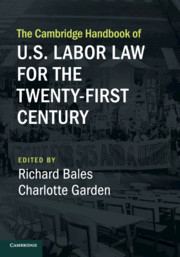Book contents
- Advance Praise for The Cambridge Handbook of U.S. Labor Law for the Twenty-First Century
- The Cambridge Handbook of U.S. Labor Law for the Twenty-First Century
- The Cambridge Handbook of U.S. Labor Law for the Twenty-First Century
- Copyright page
- Contents
- Contributors
- Preface
- Acknowledgments
- Part I Introduction
- Part II Labor Law Is Out of Date
- Part III The “Fissured” Workplace
- Part IV Barriers to Forming a Collective Bargaining Relationship
- 17 Tactical Mismatch in Union Organizing Drives
- 18 The Power of Place
- 19 Assembly and Collective Rights
- 20 Leveraging Secondary Activity Within and Outside Legal Boundaries
- 21 Captive Audience Meetings
- Part V Barriers to Bargaining a Good Contract
- Part VI Unions, Civil Society, and Culture
20 - Leveraging Secondary Activity Within and Outside Legal Boundaries
from Part IV - Barriers to Forming a Collective Bargaining Relationship
Published online by Cambridge University Press: 01 November 2019
- Advance Praise for The Cambridge Handbook of U.S. Labor Law for the Twenty-First Century
- The Cambridge Handbook of U.S. Labor Law for the Twenty-First Century
- The Cambridge Handbook of U.S. Labor Law for the Twenty-First Century
- Copyright page
- Contents
- Contributors
- Preface
- Acknowledgments
- Part I Introduction
- Part II Labor Law Is Out of Date
- Part III The “Fissured” Workplace
- Part IV Barriers to Forming a Collective Bargaining Relationship
- 17 Tactical Mismatch in Union Organizing Drives
- 18 The Power of Place
- 19 Assembly and Collective Rights
- 20 Leveraging Secondary Activity Within and Outside Legal Boundaries
- 21 Captive Audience Meetings
- Part V Barriers to Bargaining a Good Contract
- Part VI Unions, Civil Society, and Culture
Summary
Labor was at its pinnacle when secondary activities (e.g., picketing, boycotting, leafletting) were lawful. In 1947 and again in 1957 and 1959, Congress amended the National Labor Relations Act, severely curtailing secondary activities, removing this effective organizing tool from labor. This Chapter explores methods unions can use, both within and outside the existing legal framework, to strengthen the collective-bargaining relationship. This chapter is divided into three sections. It starts in Section A with a brief description of the California grape workers’ strike to establish the effectiveness of secondary activity. Section B examines the historical development of secondary activity law. Section C asks how workers can leverage the legal space unoccupied by unlawful secondary conduct. Given that secondary activity is likely to remain highly regulated, it addresses what unions can do both within and outside the confines of legal boundaries to reach a larger audience to publicize their legitimate complaints.
- Type
- Chapter
- Information
- Publisher: Cambridge University PressPrint publication year: 2019
- 1
- Cited by



